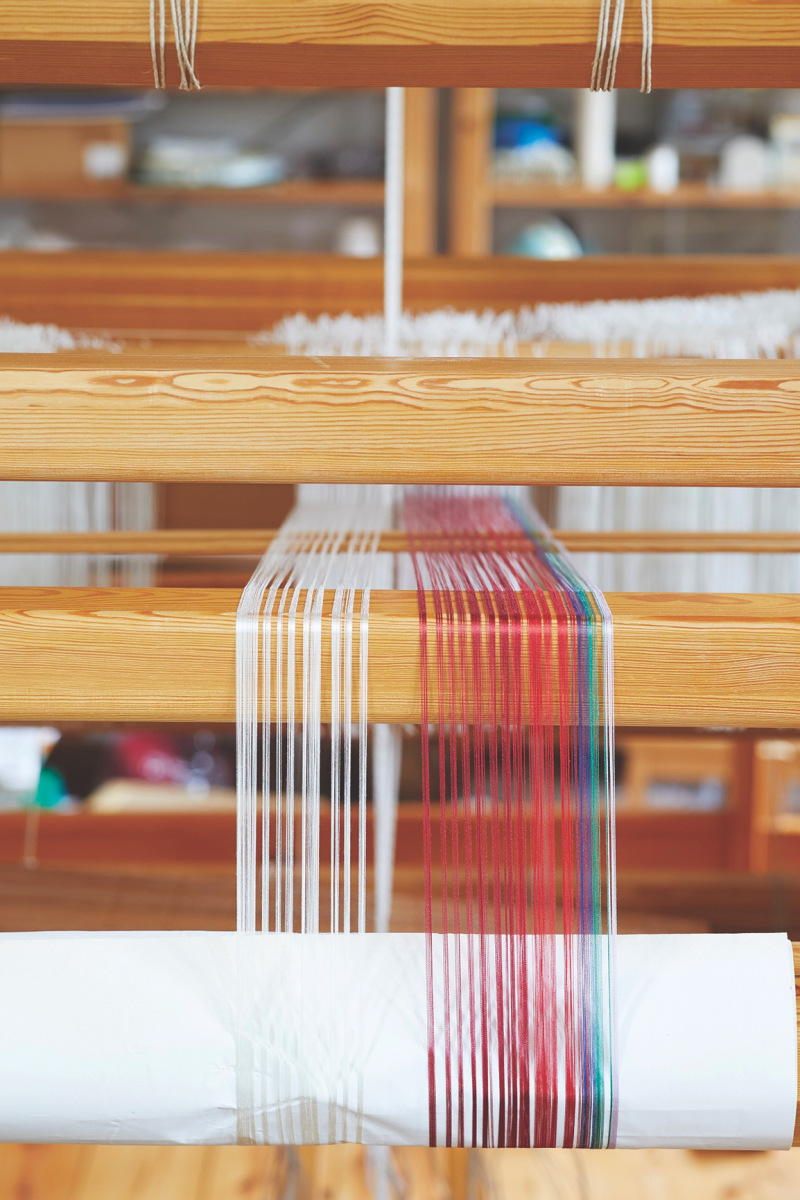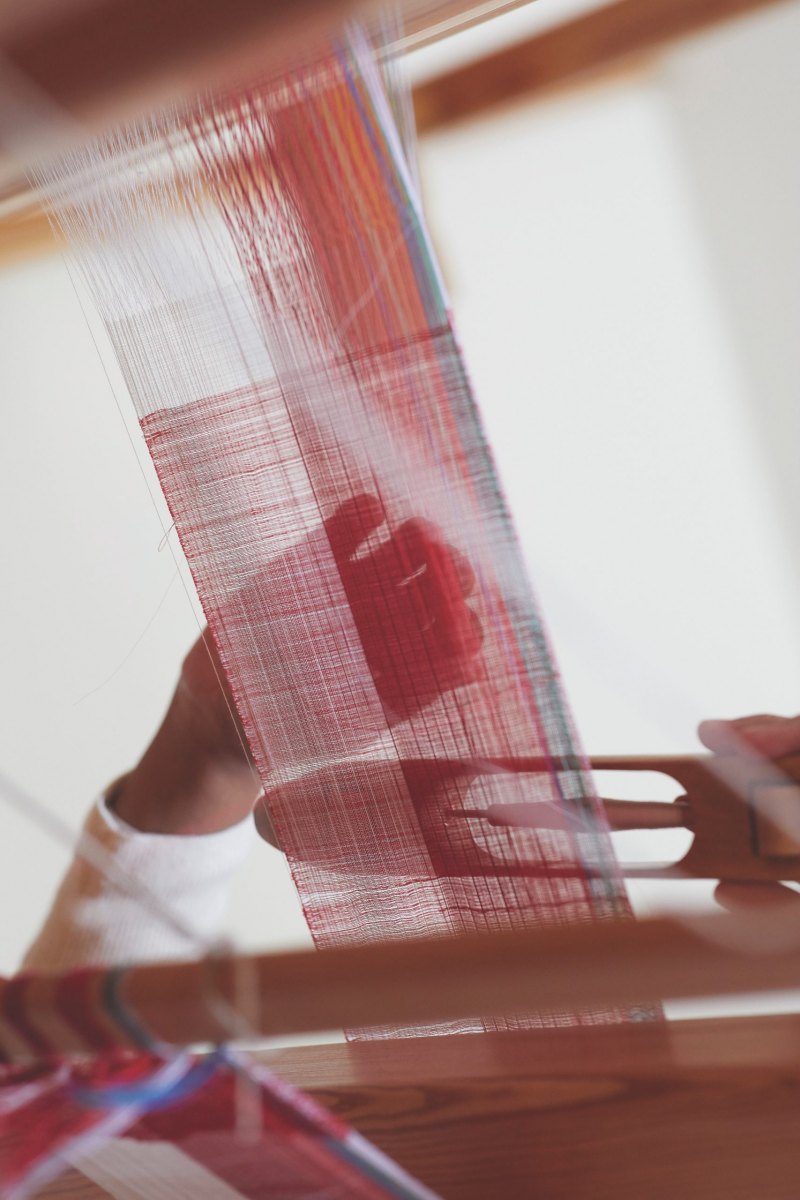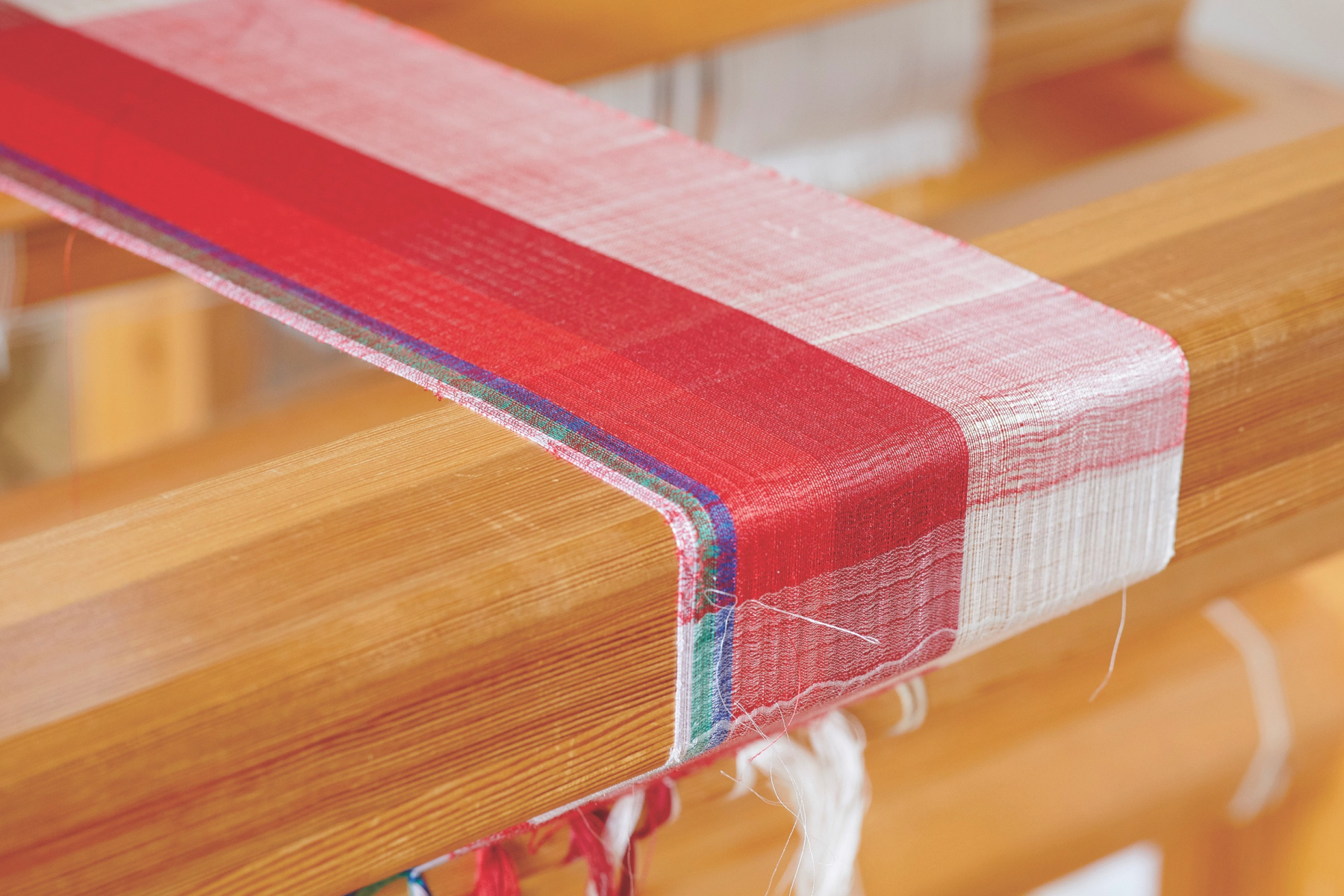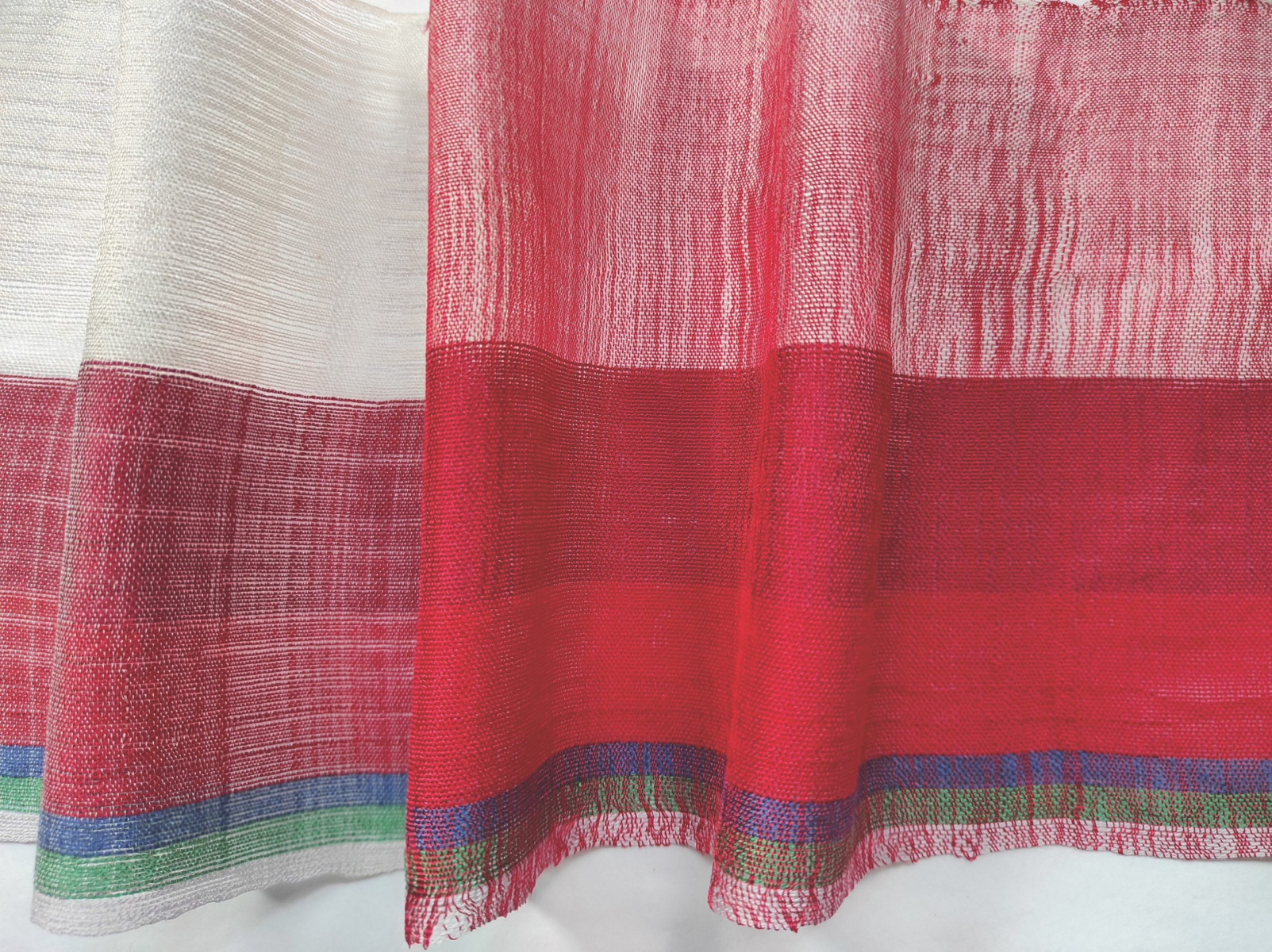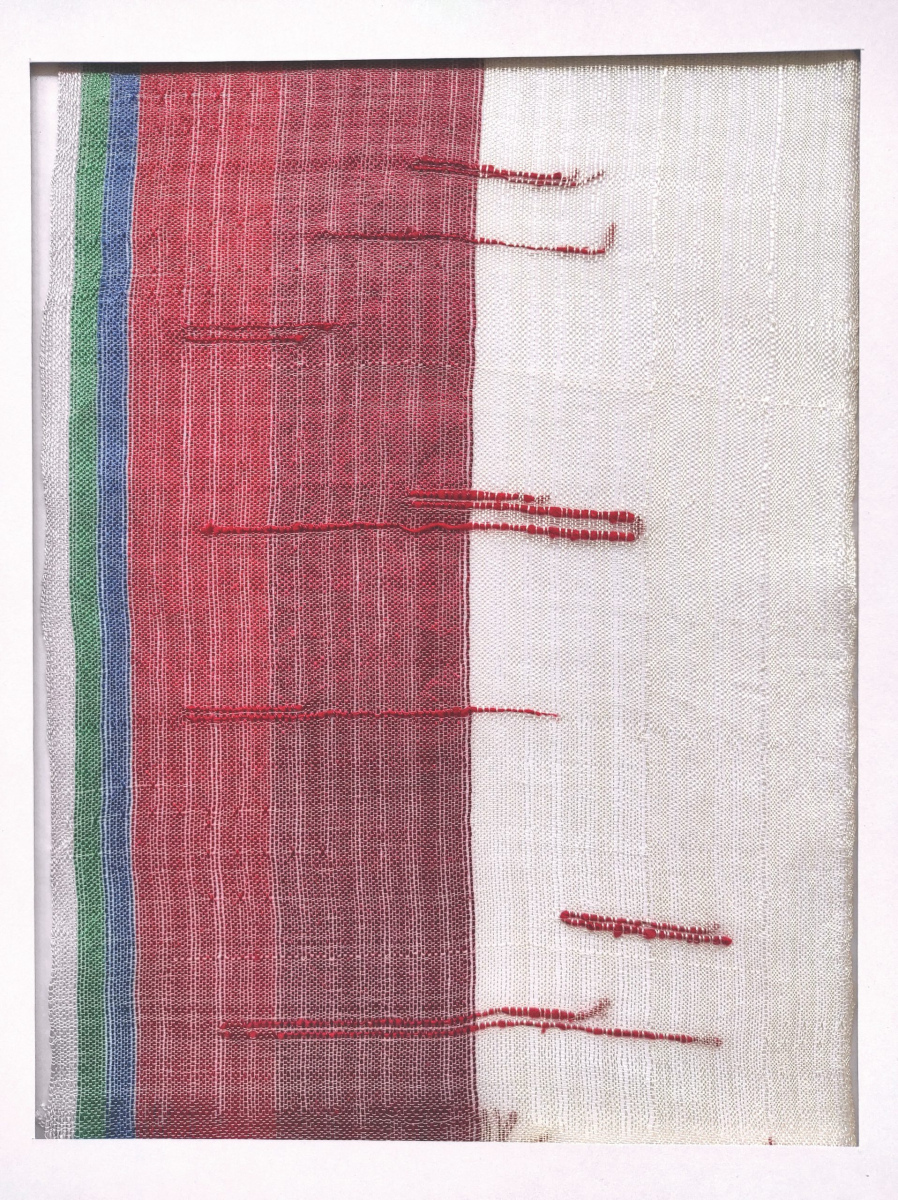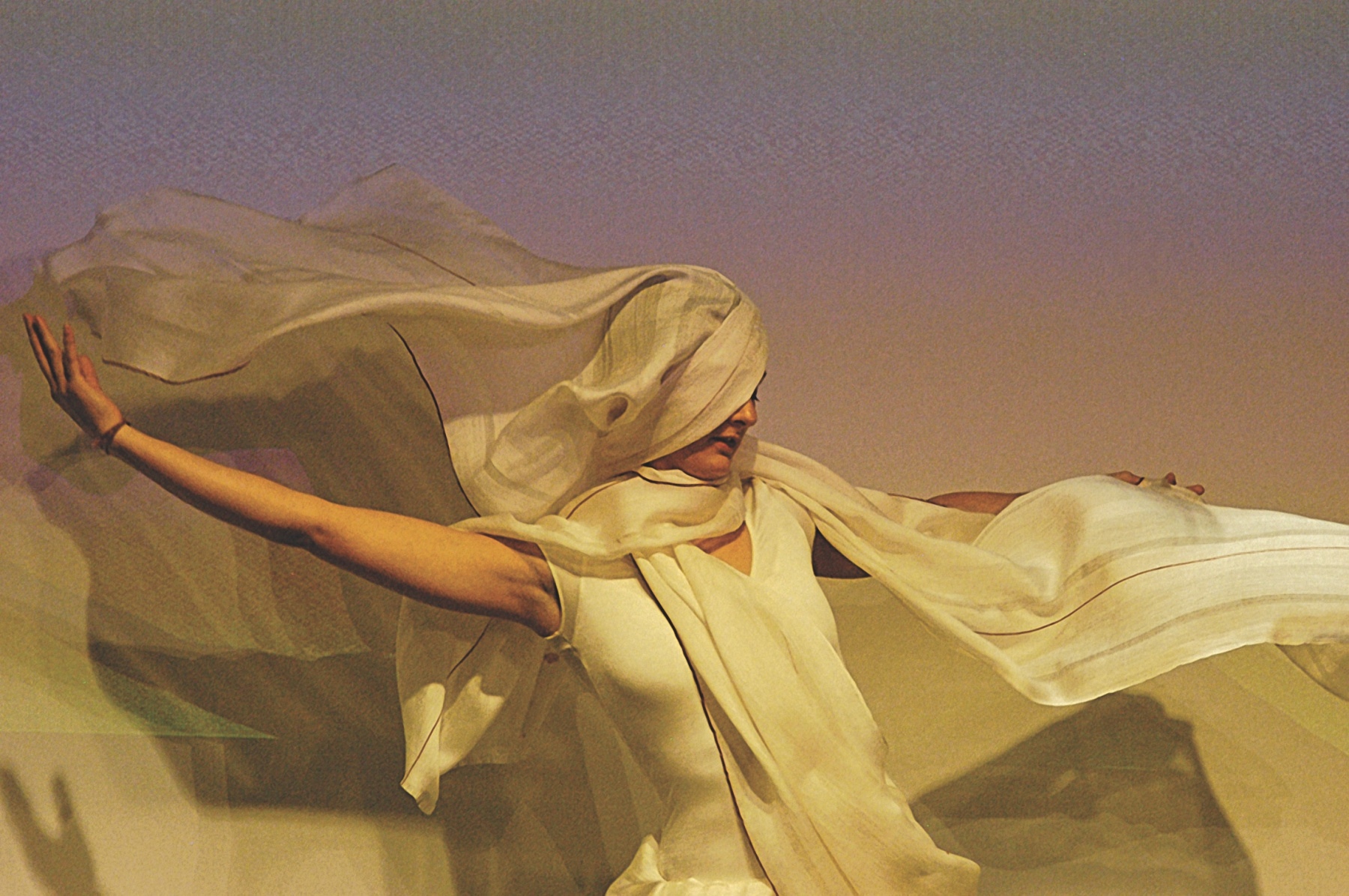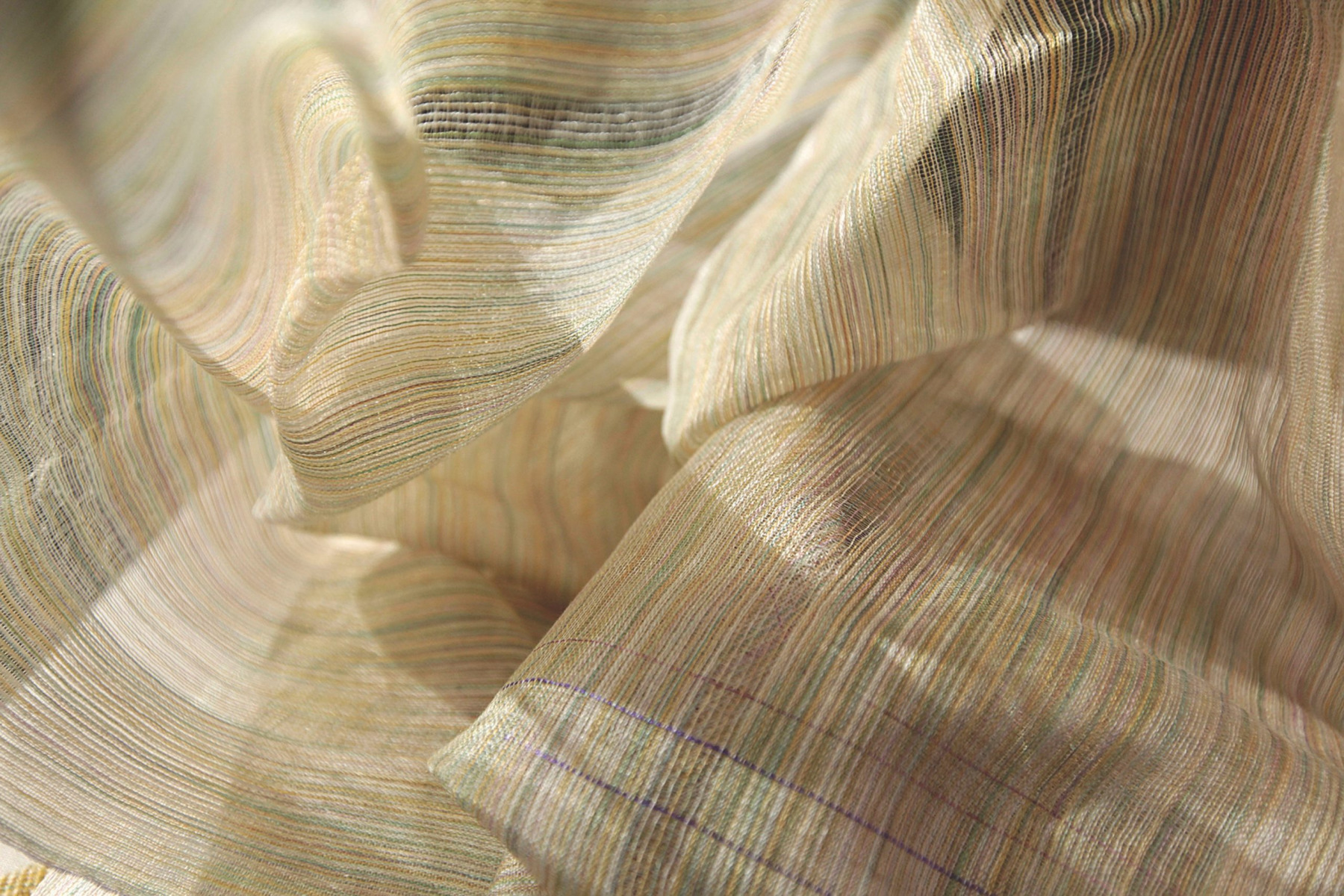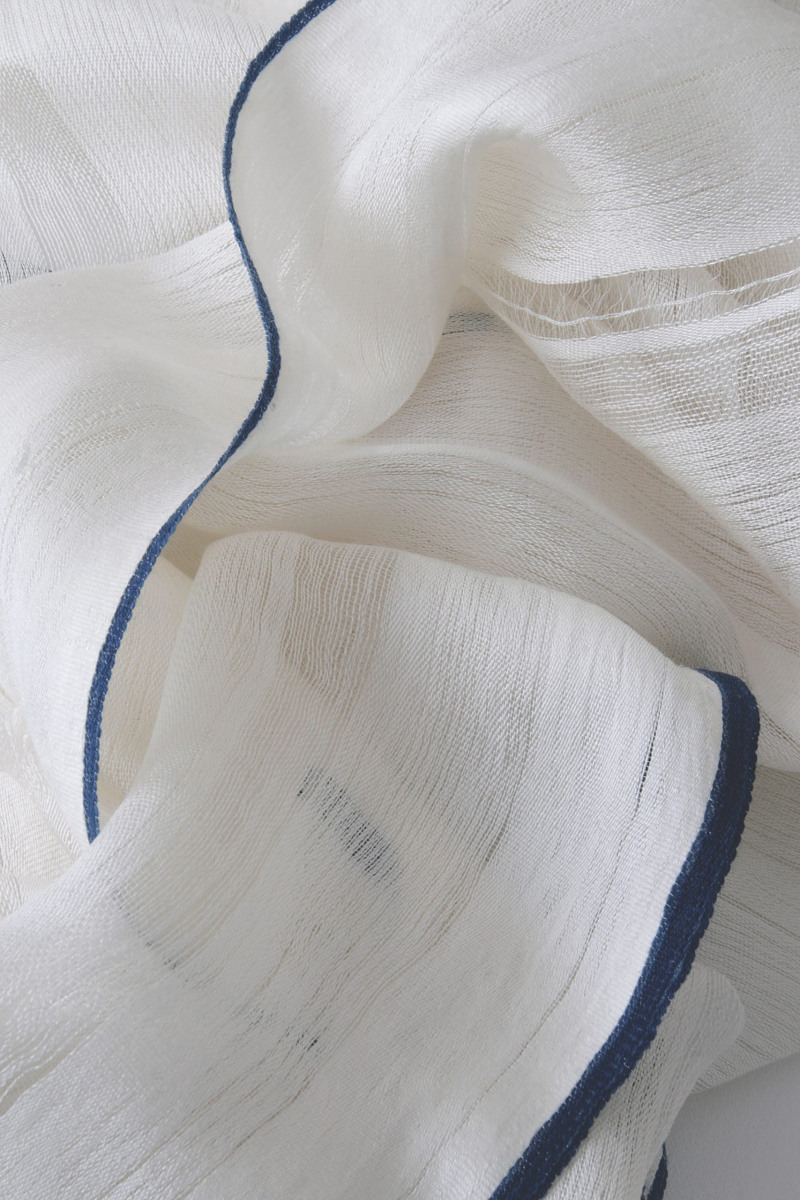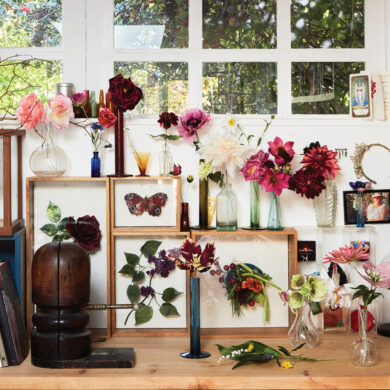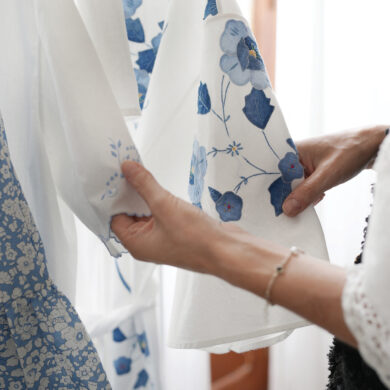Since achieving BA (hons) in Woven Textiles with a First-class degree in 1998 from the Surrey Institute of Art and Design, England, I have been passionately working with absolute determination and inspiration to revive the heritage of traditional weaving in the contemporary world of Art. As a student, my interest in handwoven textiles led me to the Victoria and Albert Museum in London, where I found an immense collection of handwoven fabrics from ancient traditional to modern contemporary and from all over the world: where you can see different cultures and religions as well as similarities and variety in technique. This was the first time where I became absolutely fascinated by the handwoven fabrics of Bangladesh Jamdani. In my research I found that Christopher Columbus had described these fabrics being so fine that one piece of cloth can pass through a signet ring. These fabrics were woven in Dhaka, East Bengal, India (now Bangladesh).

As a contemporary weaver, my passion and fascination with these fabrics kept growing and I made it my mission to find out how they were hand woven and where the designs originated from. Not to my surprise, these fabrics were handwoven using the traditional Jamdani handwoven technique of Bangladesh where the motifs are inlaid by hand, and due to the Islamic heritage of the country it used traditional Islamic geometric patterns. This is the reason why these fabrics are so unique and the Bangladeshi weavers are still trying to keep this unique craft alive. However, due to the economical climate and the lack of understanding of this traditional Bangladeshi and Islamic heritage, it is a rare craft and my research continues.
My creative and personal artistic voice, however, was born from finding a field full of dandelions seeds during a walk in the greens of Farnham in 1996. When I walked into the delicate, ethereal and tranquil moment with the magic of air and light—I knew that I wanted to capture this feeling in my weaving. But how do I capture a ‘feeling’ when weaving with yarns? Feelings can only be written, heard or explained. So, I decided to write the words in my sketchbook and captured the seeds in a clear container of Ferrero Rocher—my favourite chocolates. And this is how I began to write and express thoughts, feelings and stories with yarns!
The determination to revive the tradition of weaving grew stronger. I have now been handweaving for 25 years, delivering weave workshops in museums, galleries, festivals and schools all over Britain where not only do participants learn the tradition and craft of handweaving but explore the different cultural contents and materials, which are Islamic, Eastern and Western. I have so far self funded all my materials, tools and equipments as well as some research projects with some exception. One was the Shape of Things commission (a national initiative, led by David Kay and funded by the Arts Council, England) in 2007 for which I created a collection of artistic pieces that explored my identity, the sensuality of Islam and the tradition of Jamdani fabrics: the project allowed me to find my audience as a contemporary weaver and led to a solo show at the Craft Study Centre in Farnham, London. Every piece I created had a story, an inspiration, a feeling and a tale. They were all accompanied by sketches, records of colour, texture, photography, words and titles. For my Solo show, I dismantled seven new pieces from the ceiling in order for air, light and tranquillity to be experienced by the audiences. The show was received well and was seen how I wanted it to be seen: as an anthology of poetry.

My works are quite different and versatile. They are all much more of an art piece rather than utilitarian. It is important to note that I don’t make products such as pillow covers or napkins. I only make art/ hangings/installation pieces and scarves or shawls. My weaving is poetic and artistic in nature.
In 2011, whilst pregnant with my second child, I found that I couldn’t afford to pay for my studio at Cockpit Arts, London. This was a devastating experience for me as I had to dismantle my Counter march floor loom and store it in the house. It made me rather sad to see the loom not in use, and I knew that it would become distorted with time and parts can deteriorate, so I designed, self-funded and had a bespoke-built studio in my garden. This has not only helped me to stay committed to my mission of reviving the tradition of weaving but enabled me to weave my own artistic pieces. I have also been able to facilitate work experience to weave students at my studio. The students learn about the craft of handweaving, Jamdani technique, natural dyeing, gain knowledge and experience of weaving different types of looms, designing and how to run a craft studio. I have also been developing a collection of silk and cotton pieces which I have designed so that the traditional Bangladeshi weavers can weave them in Bangladesh, one of the least popular silk routes, where the weavers are struggling to survive.
I have collaborated with Master Calligrapher Moustafa Hassan to produce Arabic calligraphy with words that are and have been in the heart of Islamic Artists: Divine Light (Annour Alilahi). We explored how the calligraphy might look and be woven on my work. In the end we settled with projecting the Calligraphy on my pieces. This is still something I am exploring and rather than weaving word by word, I am experimenting with weaving the essence of the Arabic letters, which form an abstract freestyle and yet are meaningful.
I always say that my journey to weaving has been due to a very British Art Education. At the same time, my childhood was surrounded by arts and craft. As a baby I watched my mother embroider, my granddad design houses, mosques, schools and boats, my dad constantly decorating and changing new properties for restaurants. Food was also and still is a work of art in my family home. I do strongly believe in a higher force with which our fate is written and our influences around us guide or nurture who we become. Though my dad wanted me to become a doctor, my parents had never pressured me or my siblings toward anything but to fulfil our dreams, be happy and make a difference in the world: they were pioneers in believing in the arts during a time when it was rare for parents from any cultural background to support something which is out of the ordinary.
I always say that I have achieved recognition and success without realising or aiming for it. This is probably why l feel I haven’t succeeded, but I am aware that I have been responsible in taking weaving through a renaissance and will always push through boundaries. My work is not merely about making and achieving a final product to wear or hang. They are my journeys, my feelings and my stories. As much as they are beautiful due to my aim of capturing the Divine Light or the beauty of nature with what looks like a restrained method, it is a process which I have pioneered to it being free, contemporary and radical. I leave gaps in between yarns like spaces between words. I add extra yarns like punctuation marks and enhance the feelings of a moment. One of the most interesting experiments I have produced was a dance show with my art pieces. I worked collaboratively with ballet dancers and choreographed my pieces to be moved with their body movements. This was showcased at the Rich Mix, London, in 2007.
Currently, I am working on few projects which are all very close to my heart. In 2019 Prof. Lesley Millar (International Textile researcher and Curator) invited me to respond to ‘The Red Thread’. This fit well with what I wanted to do to do at that time. The project came to light after I had given birth to my 4th child and suddenly became so busy in my practice. I was reflecting on ‘motherhood’ and what it meant to me, how the journey in becoming a mother and being a mother affected my life as a weaver. The colour ‘Red’ was something I associated with when I was carrying my 4th baby—so I decided to look back and see the colours, words, shapes, rhythms and textures I had recorded during my other pregnancies.

I experimented with yarns on card, with watercolours and on the loom. When I looked at it all collectively—a word poem immersed out of me. I am hoping to continue experimenting and hope to achieve an installation along with the poem, perhaps in a digital form or written on the wall next to the weaving. Due to covid19 this project is postponed.
I take a very holistic approach to my work; the projects are all a process of a journey in transit: my thoughts, ideas and feelings. For example, when Lesley introduced the ‘Red Thread’ project to me, I sat and wrote about what the colour red meant to me. I collected red yarns, stones, paper and drew shapes which came to my mind. I then made a mood page in my sketchbook and experimented with winding red yarns on a card to help me decide the textures, shades and patterns. This process led me to design and make the warp (the set of yarns stretched in place on a loom before the weft is introduced during the weaving process). I weave the weft (the crosswise threads on a loom that are passed over and under the warp threads to make cloth using a shuttle) through spontaneously as all my weavings are one offs and like pieces of Art. I like to be free to change, add additional yarns in-between the wefts, but I do always refer to my sketchbook and original inspirations.
Though I have continued my practice along with motherhood, it was COVID-19 and the first Lockdown in 2020 that had made a dramatic impact in my life as a creative mother. All outside work had stopped, my husband and I were working from home, home schooling four children with no child care support. I had to reinvent our home: the living room became the classroom, the garden had to transform into a playground (from which my lawn is still suffering) and my studio became the gallery and museum to explore. Upon entering the studio, the children would amazingly settle down and create. This allowed me time on the loom, something I had to plan with child care but was now easily achieved.
Since achieving BA (hons) in Woven Textiles with a First-class degree in 1998 from the Surrey Institute of Art and Design, England, I have been passionately working with absolute determination and inspiration to revive the heritage of traditional weaving in the contemporary world of Art. As a student, my interest in handwoven textiles led me to the Victoria and Albert Museum in London, where I found an immense collection of handwoven fabrics from ancient traditional to modern contemporary and from all over the world: where you can see different cultures and religions as well as similarities and variety in technique. This was the first time where I became absolutely fascinated by the handwoven fabrics of Bangladesh Jamdani. In my research I found that Christopher Columbus had described these fabrics being so fine that one piece of cloth can pass through a signet ring. These fabrics were woven in Dhaka, East Bengal, India (now Bangladesh).

As a contemporary weaver, my passion and fascination with these fabrics kept growing and I made it my mission to find out how they were hand woven and where the designs originated from. Not to my surprise, these fabrics were handwoven using the traditional Jamdani handwoven technique of Bangladesh where the motifs are inlaid by hand, and due to the Islamic heritage of the country it used traditional Islamic geometric patterns. This is the reason why these fabrics are so unique and the Bangladeshi weavers are still trying to keep this unique craft alive. However, due to the economical climate and the lack of understanding of this traditional Bangladeshi and Islamic heritage, it is a rare craft and my research continues.
My creative and personal artistic voice, however, was born from finding a field full of dandelions seeds during a walk in the greens of Farnham in 1996. When I walked into the delicate, ethereal and tranquil moment with the magic of air and light—I knew that I wanted to capture this feeling in my weaving. But how do I capture a ‘feeling’ when weaving with yarns? Feelings can only be written, heard or explained. So, I decided to write the words in my sketchbook and captured the seeds in a clear container of Ferrero Rocher—my favourite chocolates. And this is how I began to write and express thoughts, feelings and stories with yarns!
The determination to revive the tradition of weaving grew stronger. I have now been handweaving for 25 years, delivering weave workshops in museums, galleries, festivals and schools all over Britain where not only do participants learn the tradition and craft of handweaving but explore the different cultural contents and materials, which are Islamic, Eastern and Western. I have so far self funded all my materials, tools and equipments as well as some research projects with some exception. One was the Shape of Things commission (a national initiative, led by David Kay and funded by the Arts Council, England) in 2007 for which I created a collection of artistic pieces that explored my identity, the sensuality of Islam and the tradition of Jamdani fabrics: the project allowed me to find my audience as a contemporary weaver and led to a solo show at the Craft Study Centre in Farnham, London. Every piece I created had a story, an inspiration, a feeling and a tale. They were all accompanied by sketches, records of colour, texture, photography, words and titles. For my Solo show, I dismantled seven new pieces from the ceiling in order for air, light and tranquillity to be experienced by the audiences. The show was received well and was seen how I wanted it to be seen: as an anthology of poetry.

My works are quite different and versatile. They are all much more of an art piece rather than utilitarian. It is important to note that I don’t make products such as pillow covers or napkins. I only make art/ hangings/installation pieces and scarves or shawls. My weaving is poetic and artistic in nature.
In 2011, whilst pregnant with my second child, I found that I couldn’t afford to pay for my studio at Cockpit Arts, London. This was a devastating experience for me as I had to dismantle my Counter march floor loom and store it in the house. It made me rather sad to see the loom not in use, and I knew that it would become distorted with time and parts can deteriorate, so I designed, self-funded and had a bespoke-built studio in my garden. This has not only helped me to stay committed to my mission of reviving the tradition of weaving but enabled me to weave my own artistic pieces. I have also been able to facilitate work experience to weave students at my studio. The students learn about the craft of handweaving, Jamdani technique, natural dyeing, gain knowledge and experience of weaving different types of looms, designing and how to run a craft studio. I have also been developing a collection of silk and cotton pieces which I have designed so that the traditional Bangladeshi weavers can weave them in Bangladesh, one of the least popular silk routes, where the weavers are struggling to survive.
I have collaborated with Master Calligrapher Moustafa Hassan to produce Arabic calligraphy with words that are and have been in the heart of Islamic Artists: Divine Light (Annour Alilahi). We explored how the calligraphy might look and be woven on my work. In the end we settled with projecting the Calligraphy on my pieces. This is still something I am exploring and rather than weaving word by word, I am experimenting with weaving the essence of the Arabic letters, which form an abstract freestyle and yet are meaningful.
I always say that my journey to weaving has been due to a very British Art Education. At the same time, my childhood was surrounded by arts and craft. As a baby I watched my mother embroider, my granddad design houses, mosques, schools and boats, my dad constantly decorating and changing new properties for restaurants. Food was also and still is a work of art in my family home. I do strongly believe in a higher force with which our fate is written and our influences around us guide or nurture who we become. Though my dad wanted me to become a doctor, my parents had never pressured me or my siblings toward anything but to fulfil our dreams, be happy and make a difference in the world: they were pioneers in believing in the arts during a time when it was rare for parents from any cultural background to support something which is out of the ordinary.
I always say that I have achieved recognition and success without realising or aiming for it. This is probably why l feel I haven’t succeeded, but I am aware that I have been responsible in taking weaving through a renaissance and will always push through boundaries. My work is not merely about making and achieving a final product to wear or hang. They are my journeys, my feelings and my stories. As much as they are beautiful due to my aim of capturing the Divine Light or the beauty of nature with what looks like a restrained method, it is a process which I have pioneered to it being free, contemporary and radical. I leave gaps in between yarns like spaces between words. I add extra yarns like punctuation marks and enhance the feelings of a moment. One of the most interesting experiments I have produced was a dance show with my art pieces. I worked collaboratively with ballet dancers and choreographed my pieces to be moved with their body movements. This was showcased at the Rich Mix, London, in 2007.
Currently, I am working on few projects which are all very close to my heart. In 2019 Prof. Lesley Millar (International Textile researcher and Curator) invited me to respond to ‘The Red Thread’. This fit well with what I wanted to do to do at that time. The project came to light after I had given birth to my 4th child and suddenly became so busy in my practice. I was reflecting on ‘motherhood’ and what it meant to me, how the journey in becoming a mother and being a mother affected my life as a weaver. The colour ‘Red’ was something I associated with when I was carrying my 4th baby—so I decided to look back and see the colours, words, shapes, rhythms and textures I had recorded during my other pregnancies.

I experimented with yarns on card, with watercolours and on the loom. When I looked at it all collectively—a word poem immersed out of me. I am hoping to continue experimenting and hope to achieve an installation along with the poem, perhaps in a digital form or written on the wall next to the weaving. Due to covid19 this project is postponed.
I take a very holistic approach to my work; the projects are all a process of a journey in transit: my thoughts, ideas and feelings. For example, when Lesley introduced the ‘Red Thread’ project to me, I sat and wrote about what the colour red meant to me. I collected red yarns, stones, paper and drew shapes which came to my mind. I then made a mood page in my sketchbook and experimented with winding red yarns on a card to help me decide the textures, shades and patterns. This process led me to design and make the warp (the set of yarns stretched in place on a loom before the weft is introduced during the weaving process). I weave the weft (the crosswise threads on a loom that are passed over and under the warp threads to make cloth using a shuttle) through spontaneously as all my weavings are one offs and like pieces of Art. I like to be free to change, add additional yarns in-between the wefts, but I do always refer to my sketchbook and original inspirations.
Though I have continued my practice along with motherhood, it was COVID-19 and the first Lockdown in 2020 that had made a dramatic impact in my life as a creative mother. All outside work had stopped, my husband and I were working from home, home schooling four children with no child care support. I had to reinvent our home: the living room became the classroom, the garden had to transform into a playground (from which my lawn is still suffering) and my studio became the gallery and museum to explore. Upon entering the studio, the children would amazingly settle down and create. This allowed me time on the loom, something I had to plan with child care but was now easily achieved.




